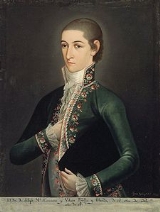
José María Cervantes y Velasco
Encyclopedia
José María Cervantes y Altamirano de Velasco Padilla y Obando (born ca. 1785), Count of Santiago de Calimaya and Marquess of Salinas, was a Mexican
army officer who signed the Act of Independence of the Mexican Empire along Agustín de Iturbide
and his uncle, Juan María Cervantes y Padilla.
He was the son of Ignacio Gómez de Cervantes and doña Marina Altamirano de Velasco, countess of Santiago de Calimaya and Marquise of Salinas. He entered the Spanish
royal army in 1810 as captain in the Distinguished Patriots of Ferdinand VII battalions created by Viceroy Francisco Javier Venegas, rose to colonel in 1813 and joined the Mexican independence movement in 1815.
He married twice in his life; first to doña María Michaus y Oroquieta and the later to doña Ana María Ozta y Cotera, Marquise of Rivascacho, with whom he had a son: don José María Cervantes Ozta, who inherited his title and, after marrying doña Magdalena Ayestarán, fathered don Ignacio Cervantes Ayestarán, the last count of Santiago de Calimaya before Mexico's independence,who married Carmen Cauz and had not descendants; and Guadalupe Cervantes Ayestarán who married Don Francisco Cauz and whose descendants would have inherited the titles .
, but it is not on view. It was signed and dated , and according to María Concepción Amerlinck, it's attributed to Ignacio Remigio Ayala, author of a portrait of Manuel Valdés (a famous printer and publisher) and several other works that hanged in 1807 at the Convent of , in Mexico City
.
The portrait —measuring 83.82 by 63.8 cm (33 by 25.1 in) and painted in oil over canvas— shows Cervantes with his upper head shaved, wearing a green silk dress coat and white vest embroidered with flowers in Neoclassical
style, lace frill and sleeves, and holding a tricorn black hat with his left hand while keeping his right hand inside the coat at heart level; a posture common in male portraits of the period according to the Brooklyn Museum. According to Amerlinck, his stiff posture and tube-like rendering of his arms indicate an early search for abstraction pursued by some local artists of the period.
Mexico
The United Mexican States , commonly known as Mexico , is a federal constitutional republic in North America. It is bordered on the north by the United States; on the south and west by the Pacific Ocean; on the southeast by Guatemala, Belize, and the Caribbean Sea; and on the east by the Gulf of...
army officer who signed the Act of Independence of the Mexican Empire along Agustín de Iturbide
Agustín de Iturbide
Agustín Cosme Damián de Iturbide y Aramburu , also known as Augustine I of Mexico, was a Mexican army general who built a successful political and military coalition that was able to march into Mexico City on 27 September 1821, decisively ending the Mexican War of Independence...
and his uncle, Juan María Cervantes y Padilla.
He was the son of Ignacio Gómez de Cervantes and doña Marina Altamirano de Velasco, countess of Santiago de Calimaya and Marquise of Salinas. He entered the Spanish
Spain
Spain , officially the Kingdom of Spain languages]] under the European Charter for Regional or Minority Languages. In each of these, Spain's official name is as follows:;;;;;;), is a country and member state of the European Union located in southwestern Europe on the Iberian Peninsula...
royal army in 1810 as captain in the Distinguished Patriots of Ferdinand VII battalions created by Viceroy Francisco Javier Venegas, rose to colonel in 1813 and joined the Mexican independence movement in 1815.
He married twice in his life; first to doña María Michaus y Oroquieta and the later to doña Ana María Ozta y Cotera, Marquise of Rivascacho, with whom he had a son: don José María Cervantes Ozta, who inherited his title and, after marrying doña Magdalena Ayestarán, fathered don Ignacio Cervantes Ayestarán, the last count of Santiago de Calimaya before Mexico's independence,who married Carmen Cauz and had not descendants; and Guadalupe Cervantes Ayestarán who married Don Francisco Cauz and whose descendants would have inherited the titles .
Portrait by Ignacio Ayala
His portrait is part of the Museum Collection Fund and the Dick S. Ramsay Fund of the Brooklyn MuseumBrooklyn Museum
The Brooklyn Museum is an encyclopedia art museum located in the New York City borough of Brooklyn. At 560,000 square feet, the museum holds New York City's second largest art collection with roughly 1.5 million works....
, but it is not on view. It was signed and dated , and according to María Concepción Amerlinck, it's attributed to Ignacio Remigio Ayala, author of a portrait of Manuel Valdés (a famous printer and publisher) and several other works that hanged in 1807 at the Convent of , in Mexico City
Mexico City
Mexico City is the Federal District , capital of Mexico and seat of the federal powers of the Mexican Union. It is a federal entity within Mexico which is not part of any one of the 31 Mexican states but belongs to the federation as a whole...
.
The portrait —measuring 83.82 by 63.8 cm (33 by 25.1 in) and painted in oil over canvas— shows Cervantes with his upper head shaved, wearing a green silk dress coat and white vest embroidered with flowers in Neoclassical
Neoclassicism
Neoclassicism is the name given to Western movements in the decorative and visual arts, literature, theatre, music, and architecture that draw inspiration from the "classical" art and culture of Ancient Greece or Ancient Rome...
style, lace frill and sleeves, and holding a tricorn black hat with his left hand while keeping his right hand inside the coat at heart level; a posture common in male portraits of the period according to the Brooklyn Museum. According to Amerlinck, his stiff posture and tube-like rendering of his arms indicate an early search for abstraction pursued by some local artists of the period.

